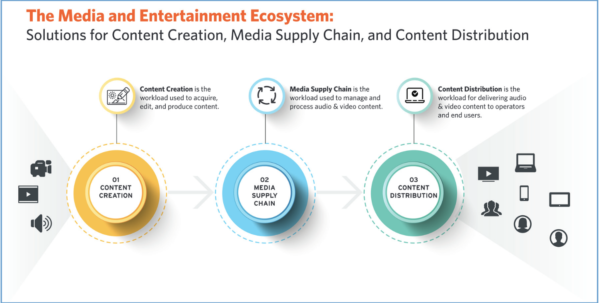
M&E Journal: Navigating the Media and Entertainment Cloud Ecosystem in 2021 and Beyond
Over the last few years, technological innovation has sparked a massive and unprecedented renaissance in the M&E industry, transforming everything from content creation and distribution to the media supply chain and processes for every workload.
Remote production, artificial intelligence and machine learning are creating exciting new opportunities for creating content, driving user engagement, and mining data for business intelligence.
And as media consumption continues to break records, cloud technologies are making fixed storage and distribution costs — and the risks they create for businesses — a thing of the past.
Evolving cloud technologies have accelerated not only the speed of change, but also opportunities for unprecedented optimization in media workloads for organizations that have the foresight and insight necessary to seize on them.
The downside of this rapid evolution is that many enterprises are tangled in confusion: one foot in the past with their legacy systems, the other foot in the present working to determine which new piece of technology will actually work.
The “spaghetti ball” of entangled systems slows down innovation and misses opportunities the organization and its customers would benefit from by moving to the cloud. Only by understanding the end-to-end map of the cloud can organizations create a cohesive, organization-wide ecosystem optimized for their cross-functional needs and thereby leverage the full power of the cloud.
 THE IMPACT OF COVID-19
THE IMPACT OF COVID-19
As lockdowns spread across the globe, basic assumptions about how to create, manage, and distribute media changed almost overnight. The industry rushed to pivot to remote work while adapting to shifting consumer habits. The tools were all there for companies to rapidly capitalize on emerging opportunities.
At the same time, profits and stock prices for many major industry players plunged in 2020; Disney’s prof-its fell 91 percent in Q1 of 2020, and WarnerMedia/AT&T’s stock price dropped 30 percent at the end of the same quarter and has remained mostly flat.
Streaming service use ballooned, but converting trial memberships to paying subscriptions proved challenging.
Overall, early 2020 projections estimated a $160 billion loss in the M&E sector over the next five years. As the industry wrestled with those challenges, the cloud sector boomed. M&E companies, along with other sectors, jumped at the opportunity to access scalable, cost-conscious solutions to transform their operations in the new environment.
It’s been a scramble fraught with obstacles, especially for media titans whose mass of tech stacks and siloed divisions stand in the way of rapid and efficient changes.
Yet within that flurry of activity, impressive achievements have emerged — 33 million Peacock users in Q4 of 2020, successful streaming launches of several major films — and more organizations are waking up to the need for a cloud-based reimagining of their media workloads.
A TECHNOLOGICAL TANGLE
The evolution of M&E technology has created a combination of opportunities and challenges. As new technologies emerge, the industry has remained reliant, in part, on older technology. Legacy technology built well over two decades ago is commingled with much newer technology — hence the spaghetti ball of systems many enterprises are grappling with.
The complexity of these commingled systems — which are common throughout the industry — fosters an environment in which many players don’t even under-stand the tech options available or how to leverage them.
Few have a clear sense of systems outside of what they’re currently using, making it difficult for decision-makers to be aware of and achieve the state of the art.
And in some cases, even an organization’s own systems — built by accretion for decades — are mysterious to those working within them.Thus far, no holistic guide to the cloud universe for M&E has been available to help companies streamline their media workflows.
Without that roadmap, money is wasted — to the tune of hundreds of millions across the industry — and untapped opportunities leave billions of dollars on the cutting room floor.
Peacock’s aforementioned success in signing up new users has come with an impressive price tag: an estimated $2 billion dollars in losses in 2020 and 2021. Not to be outdone, AT&T has committed $4 billion to HBO Max over the next three years.
 THREE MEDIA WORKLOADS YOU NEED TO KNOW
THREE MEDIA WORKLOADS YOU NEED TO KNOW
Amazon Web Services (AWS) is an industry leader in cloud and media workload optimization, and AWS partners like Metal Toad serve to bring the power of cloud to M&E enterprises — creating the custom roadmap each company needs to create an optimized, scalable cloud ecosystem.
The first step for M&E leaders is getting a clear picture of the landscape, the current tools, and what constitutes a best-in-class and most cost-effective media workflow.These workloads consist of over two dozen technology functions; understanding what these are and how they work together reveals the universe of cloud services and products that M&E organizations can combine to revolutionize their capabilities and costs.
Together, these three workloads form a chain that allows media content to be produced and broadcast smoothly to millions of people all over the world with high quality. Optimizing this tech stack — and bringing them together seamlessly — will be a primary driver of success in the industry.
1. The content creation workload is the acquisition, editing, and production of audio and/or visual content. All content flows through this workload. This includes encoding, transport and ingest, remote editing, production storage, and much more.
2. The media supply chain workload is used to manage and process audio and visual content. Arguably, the internal supply chain is the most complex element of the M&E ecosystem. Legacy technology in particular can create bottlenecks that severely hamper flexibility.
3. The content distribution workload describes how audio and video content is delivered to operators and end-users. This includes rights and entitlements, subscriber management, analytics, video and audio playback, and more.
Here’s a real-world example of the three media workloads in action: during the live broadcast of a sporting event, videos captured by on-site cameras are transmitted through the network, stored and transcoded in the cloud, transferred to the platform layer for content delivery and media resource management, and finally played to the end-user.
At a technical level, this work involves network resource scheduling, node management, route planning, route node tuning, and even million-level concurrent balancing and P2P content distribution and transmission.
As you can see, a cohesive approach to building media workloads is crucial: each workload must flow seamlessly into the next to maximize quality while minimizing costs.
SEIZE THE POWER OF CLOUD WORKFLOWS
As you navigate the ever-shifting technological landscape — and the ongoing effects of a global pandemic — cluing in to the cloud is key to not just keeping up, but leading the pack. Metal Toad, an AWS Advanced Consulting Partner, is dedicated to demystifying the cloud and implementing its benefits for the industry.
That’s why we created a comprehensive guide to the M&E cloud ecosystem: a deep dive into the workloads and their functions to help you identify what a best-in-class media workflow can look like for your enterprise.
In the white paper, you’ll also find AWS Partners who can implement solutions for you, plus find out how Metal Toad can help bring it all together and transform your tangled tech into a well-oiled machine.
* By Joaquin Lippincott, CEO, Founder, Tony Rost, CTO, Metal Toad
=============================================
Click here to download the complete .PDF version of this article
Click here to download the entire Spring 2021 M&E Journal
